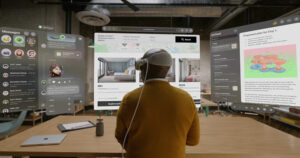Linux desktop developers may see an increase in adoption in 2025 despite the lack of commercial marketing strategies hawking the benefits of running Linux on consumer computers.
The arrival of the New Year brings a crucial decision for millions of computer users worldwide. In just 10 months, Microsoft will end support for Windows 10, leaving users with three options: upgrade to Windows 11 (if eligible), pay steep subscription fees for extended security support, or explore alternative computing solutions.
Microsoft hopes many Windows 10 users will reluctantly purchase new, more powerful devices to meet Windows 11’s upgrade requirements. For those unwilling to do so, the search for alternatives begins.
Switching to Linux offers both convenience and cost savings. Upgrading to Linux is free, and you can install it on your existing hardware to replace Windows.
Options for stranded Windows 10 users include switching to costlier macOS-based devices or adopting Chromebooks with ChromeOS, a less expensive, cloud-focused ecosystem. Another proven alternative is letting Linux breathe new life into existing hardware with a free, customizable operating system.
With the Windows 10 security updates and support deadline looming on Oct. 4, 2025, Linux developers see a potential for Windows users to switch, potentially marking 2025 as “The Year of the Linux Desktop.” According to a recent Forbes article, “nearly 900 million Windows 10 users are still holding out,” presenting a significant opportunity for Linux adoption.
These potential Linux converts will be joined by existing Linux users exploring upgrade options to other distributions. Unlike Microsoft and Apple platforms, Linux is not a single operating system. Instead, it offers dozens of highly configurable distributions with unique features and desktop environments, providing users with unparalleled customization options.
Its diverse ecosystem offers options tailored to various needs, giving users unparalleled flexibility to shape their computing experience. Special tools even let die-hard Windows fans run their favorite Microsoft applications inside the Linux desktop.
Exploring Linux Without Installing It
One of my favorite Linux discovery sites was DistroTest.net, which shut down several years ago. It was a novel way to sample dozens of Linux desktops and distros from a browser tab. I could select from some 300 Linux distros running on a virtual machine (VM) the site hosted without installing or configuring anything.
Several websites offer similar capabilities using emulators. These sites run software programs that allow a computer system to mimic the functions of another system. These online tools simplify the journey of Windows 10 users hesitant to upgrade and Linux users eager to try something new. They offer ease of use when exploring the range of Linux distributions, from beginner-friendly options to advanced environments.
Setting up and using emulators locally on your computer is a drawback to adoption for inexperienced computer users. However, a few user-friendly options let you explore free, fully functional Linux operating systems without leaving your web browser in whatever other computer platform you use.
Although these websites’ Linux inventories are less extensive, they let you sample Linux without installing it on your machine. This approach gives potential new users an easier way to test drive Linux distros in their web browsers without downloading and configuring files. All you need is an internet connection and a web browser.
Online Emulators To Help Find Linux Gems
Unfortunately, no genuinely adequate replacement for DistroTest.net exists. Linux developers lack a commercial marketing mechanism to drive adoption, as no company owns the Linux OS. If developers offered an emulator tool on their websites, potential adopters could experience the Linux version more easily before downloading and installing it on their computers.
These four websites help fill the void of selecting and trying out various Linux offerings:
DistroSea hosts more than 50 Linux distros, offering a beginner-friendly way to explore options. When the website loads in your browser window, scroll through the installed options and click on a distro to try.

DistroSea requires just a few clicks to load Pop!OS Linux into a web browser window.
OnWorks offers a more limited selection of Ubuntu, Parrot Security OS, Elementary OS, and Fedora Linux distros. It also lets you try out the Wine app to run Windows programs in Linux, Kodi Media Center, and a Windows and Mac emulator. However, the site is plastered with ads, which mar the experience.

This OnWorks view shows Elementary OS Linux running in a web browser.
LabEx offers a different user experience. It connects you to an online Linux terminal and a playground environment with a user-friendly interface for interacting with a complete Ubuntu 22.04 environment. It is free to use, but you must create an account to get started. LabEx offers multiple interfaces and integration with structured courses that create a solid platform to learn about using Linux. However, it lacks access to any other Linux distributions to try.

LabEx lets you run Linux from any web browser and learn various Linux skills, all with the click of buttons.
JSLinux is a web service on Bellard.org that runs Linux and Windows VMs for free. It runs the virtualization software remotely. Click the startup link from the menu box to choose either Alpine Linux or Fedora Workstation Linux.

Bellard’s JSLinux service shows the Dillo web browser running within Alpine Linux through a web-based connection.
More Resources for Linux Beginners
Whether you’re exploring Linux for the first time or looking to expand your expertise, Linux offers unparalleled flexibility and functionality. Start by sampling distributions online and see how Linux can elevate your computing experience.
See our other articles for more information about selecting Linux distros and options for buying new computers with Linux pre-installed. Also, check out Insider Tips for Buying a New Personal Computer.






















































